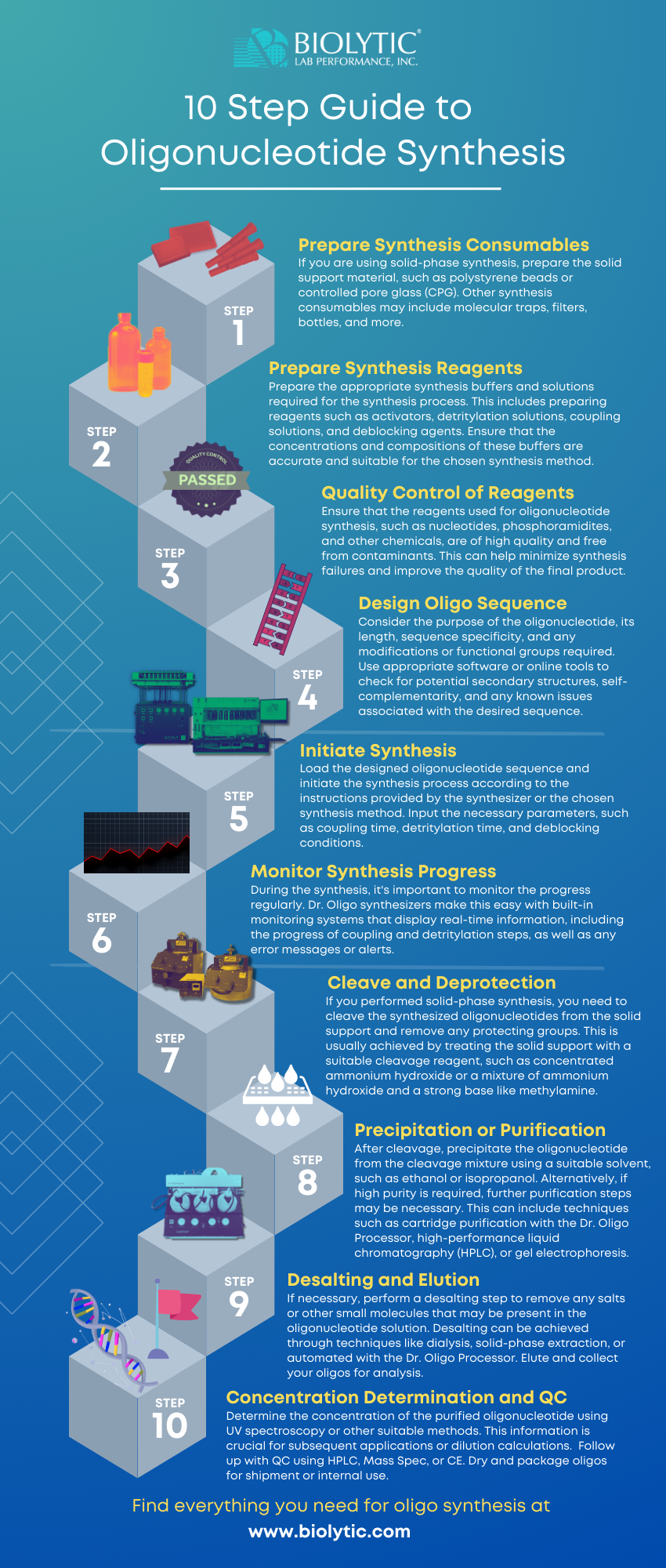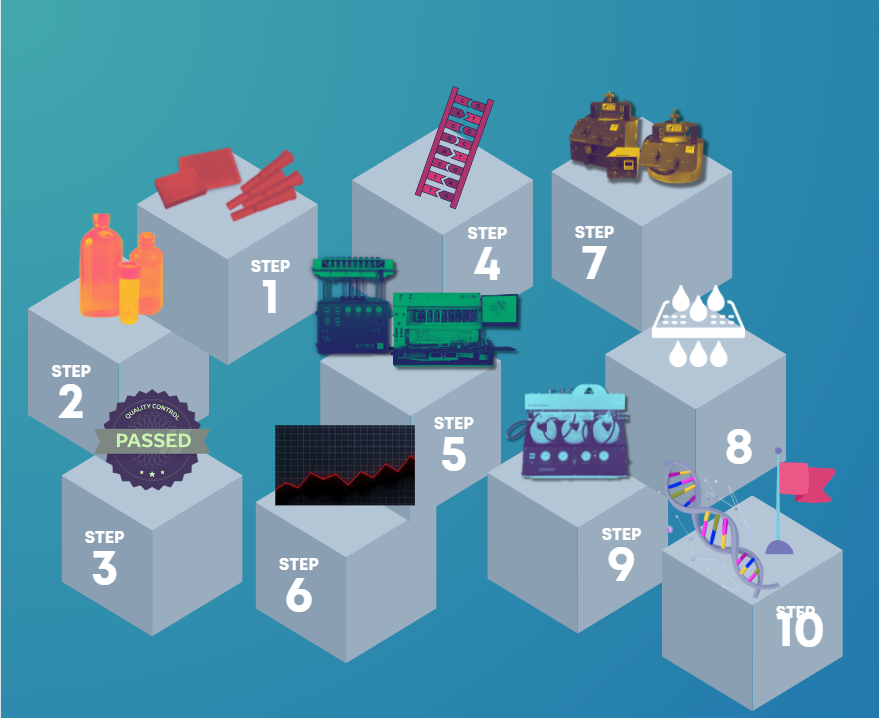Oligonucleotides play a pivotal role in modern molecular biology, serving as indispensable tools in various applications such as PCR, gene synthesis, gene editing, and diagnostic assays. In this comprehensive guide, we will walk you through the ten essential steps involved in oligonucleotide synthesis, covering everything from sequence design to post-synthesis purification and characterization. Whether you are a novice in the field or looking to refine your existing skills, this step-by-step roadmap will equip you with the knowledge and techniques necessary to successfully synthesize high-quality oligonucleotides.


- Prepare Synthesis Consumables
- If you are using solid-phase synthesis, prepare the solid support material, such as polystyrene beads or controlled pore glass (CPG). We carry synthesis plates and columns at various scales, and other synthesis consumables including molecular traps, filters, bottles, and more.
- Prepare Synthesis Reagents
- Prepare the appropriate synthesis buffers and solutions required for the synthesis process. This includes preparing reagents such as activators, detritylation solutions, coupling solutions, and deblocking agents. Ensure that the concentrations and compositions of these buffers are accurate and suitable for the chosen synthesis method. Our molecular traps can prolong the shelf life of your reagents.
- Quality Control of Reagents
- Ensure that the reagents used for oligonucleotide synthesis, such as nucleotides, phosphoramidites, and other chemicals, are of high quality and free from contaminants. Routinely using and changing your filters can help minimize synthesis failures and improve the quality of the final product.
- Design Oligo Sequence
- Consider the purpose of the oligonucleotide, its length, sequence specificity, and any modifications or functional groups required. Use appropriate software or online tools to check for potential secondary structures, self-complementarity, and any known issues associated with the desired sequence.
Find all the oligonucleotide synthesis consumables and pre-synthesis accessories you need on our website: DNA RNA Oligo Synthesis Consumables | Biolytic Lab Performance

5. Initiate Synthesis
- Load the designed oligonucleotide sequence and initiate the synthesis process according to the instructions provided by the synthesizer or the chosen synthesis method. Our Dr. Oligo synthesizers allow full customization of synthesis parameters, such as coupling time, detritylation time, deblocking conditions, and more.
6. Monitor Synthesis Process
- During the synthesis, it’s important to monitor the progress regularly. Dr. Oligo synthesizers make this easy with built-in monitoring systems that display real-time information, including the progress of coupling and detritylation steps, as well as any error messages or alerts.
We have DNA RNA oligonucleotide synthesizers for any application. From low/medium throughput research projects to high/ultra-high throughput oligo production, find the right Dr. Oligo synthesizer here: Oligo / RNA / DNA Synthesizers (biolytic.com)

7. Cleave and Deprotection
- If you performed solid-phase synthesis, you need to cleave the synthesized oligonucleotides from the solid support and remove any protecting groups. This is usually achieved by treating the solid support with a suitable cleavage reagent, such as concentrated ammonium hydroxide or a mixture of ammonium hydroxide and a strong base like methylamine. Easily automate this process using our Heated Pressure Chamber.
8. Precipitation or Purification
- After cleavage, precipitate the oligonucleotide from the cleavage mixture using a suitable solvent, such as ethanol or isopropanol. Alternatively, if high purity is required, further purification steps may be necessary. This can include techniques such as cartridge purification with the Dr. Oligo Processor, high-performance liquid chromatography (HPLC), or gel electrophoresis.
9. Desalting and Elution
- If necessary, perform a desalting step to remove any salts or other small molecules that may be present in the oligonucleotide solution. Desalting can be achieved through techniques like dialysis, solid-phase extraction, automated with the Dr. Oligo Processor. Elute and collect your oligos for analysis.
10. Concentration Determination and QC
- Determine the concentration of the purified oligonucleotide using UV spectroscopy or other suitable methods. This information is crucial for subsequent applications or dilution calculations. Follow up with QC using HPLC, Mass Spec, or CE. Dry and package oligos for shipment or internal use.
Biolytic Lab Performance, Inc. offers automated post-processing accessories and instruments to streamline your oligo processing: DNA / RNA / Oligonucleotide Synthesizers | Oligo Processors (biolytic.com)
Understanding oligonucleotide synthesis opens a world of possibilities in your molecular biology research. As you begin or refine your oligo synthesis journey, Biolytic Lab Performance, Inc. provides the reliable tools and equipment you need for streamlined and successful oligonucleotide synthesis. With our high-quality DNA RNA oligo synthesis accessories and Dr. Oligo DNA RNA oligo synthesizers, we are your partner in oligo synthesis and are here to support your scientific breakthroughs.





